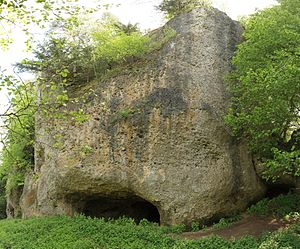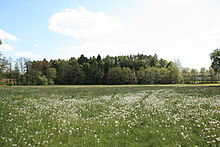Burgstall Gernotenstein
| Burgstall Gernotenstein | ||
|---|---|---|
|
Burgstall Gernotenstein - View of the castle rock from the west |
||
| Alternative name (s): | Huwenstein | |
| Creation time : | 11th century | |
| Castle type : | Höhenburg, spur location | |
| Conservation status: | Burgstall | |
| Place: | Auerbach in the Upper Palatinate- Michelfeld | |
| Geographical location | 49 ° 42 '16 .4 " N , 11 ° 35' 33.4" E | |
| Height: | 415 m above sea level NN | |
|
|
||
The high medieval Burgstall Gernotenstein , also known as Burgstall Huwenstein , is the remainder of an abandoned spur castle that once rose on a rocky reef above the valley of the Speckbach. The Burgstall is located east of the parish village Michelfeld in the municipality of Auerbach in the Upper Palatinate in the Upper Palatinate district of Amberg-Sulzbach in Bavaria , Germany . The castle, which may have housed a cave church, has now been completely gone, except for small remains.
Geographical location
The site of the former castle is 415 m above sea level. NN in the eastern part of the Frankenjura low mountain range , on a small mountain spur running from southeast to northwest , which is bounded on the north side by the Speckbach and drops vertically there. The western narrow side is naturally very well protected by a vertical rockfall, while the south and east sides are connected to moderately steep slopes. The Burgstall is located about 825 meters east of the Catholic cemetery church Sankt Leonhard in Michelfeld, and about 35 kilometers north-northwest of Amberg .
There are other former medieval castles in the vicinity, about 800 meters to the north is the Festenberg castle stables on the mountain of the same name above the desert of Staubershammer . A little further up the Flembach valley lies the Steinamwasser castle ruin on a rock tower in the village of the same name, and a little further up a presumed castle stables about at Gunzendorf. Another Burgstall is located on the northern outskirts of Auerbach in the Upper Palatinate near the Burgstallmühle. To the west of Michelfeld there is a tower hill in the Veldensteiner Forest near the Großer Lochstein, to the northwest there are two castle stables at Hainbronn and Nemschenreuth, and the Böheimstein castle stables near the town of Pegnitz .
History of the castle
The exact time of construction and the builder of Gernotenstein Castle are unknown, but according to the Nuremberg castle researcher Hellmut Kunstmann , the construction time was already in the 11th century. The name of the castle Gernotenstein is composed of the personal name Gernot and stone for castle, so it means the castle of Gernot . According to Kunstmann, castles with this name composition were often built in the East Franconian region before the year 1100. Examples are Pottenstein Castle , which was founded around 1060, Gößweinstein Castle , which was first mentioned in 1076, and Hiltpoltstein Castle , which was mentioned in documents from 1109 , from which noble family the builder with the rare first name Gernot came not clear.
The name Huwenstein, which is also used, comes from the old German word Huwe for owl or eagle owl and could refer to a previously used field name; these birds could have nested in small caves in the castle rock. It is not known whether Huwenstein was also used as a castle name.
The exact location of the castle was still controversial until a few years ago. Erich Freiherr von Guttenberg suspected it to be on the Breitenstein south of Punzenreuth, Kunstmann first thought of Hollenberg Castle , then later of the castle stables in Moschenreuth. The location of the castle could only be narrowed down a little more precisely through copies from the 18th century. It must have stood in the immediate vicinity of Michelfeld Monastery , only two places came into question, the Festenberg castle stables, whose castle was only built in the 14th and 15th centuries, so after the destruction of Gernotenstein Castle, and therefore not identical with this castle can be, and the rock ridge above the grounds of the monastery. Today this place is considered secured for the Gernotenstein Castle.
The castle was first mentioned in a document on May 6th, 1119 in the foundation deed of Michelfeld Monastery. The “Huwenstein, qui et Gernotestein dicitur”, or Huwenstein, which is also called Gernotestein, was mentioned among the equipment of the monastery after the village of Penzenreuth with Reisach. But there was no explicit mention of a castle. The first direct mention of Gernotestein Castle can be found in the Relatio de piis operibus Ottonis episcopi Bambergensis , the list of pious works by Bishop Otto von Bamberg , which was drawn up between 1139 and 1147 by the Michelberg provost Thiemo. There a "castellum, quod dicitur Gernotestein", ie a castle Gernotestein, is called.
Another piece of news about the castle comes from the 18th century in copies of the copy book of Michelfelder abbot Heinrich von Truppach from 1406 to 1436. Under the heading "Remarkable and worth knowing about the conditions of the monastery and the destruction of Hueben castle seu Gernotenstein" It translates as: “When godly Otto saw that this fortress was threatening the monastery, he considered that either it was undoubtedly necessary to destroy the castle or the effort expended to found the monastery below would be in vain. Therefore, exhorted by divine inspiration, he gave the entire fortifications of the place to the fire, after the relics had been removed from the chapel of St. Nicholas at the same place. Bishop Otto later buried them in a church dedicated to St. Nicholas near Michelfeld with the respect owed to the relics. The rock castle should be destroyed forever and the attempt to rebuild it should be condemned forever. "
Gernotenstein Castle was probably owned by Bishop Otto when he founded Michelfeld Monastery in 1119. He had them destroyed because he saw them as an (economic) threat to the monastery.
Today the rock of the former castle is heavily overgrown with trees and shrubbery, only remnants such as a small piece of wall in a deep crevice and traces of rock processing have survived. The freely accessible castle stables can be reached via a poorly recognizable path behind the monastery cemetery.
The ground monument registered by the Bavarian State Office for the Preservation of Monuments as "Medieval Burgstall Huwenstein / Gernotestein with the Guckerloch Cave (A 44), perhaps a cave church" has the monument number D-3-6235-0004.
literature
- Stefan Helml: Castles and palaces in the Amberg-Sulzbach district . Druckhaus Oberpfalz, Amberg 1991, pp. 121–123.
- Hellmut Kunstmann : Communications of the Altnürnberger landscape . Published by Altnürnberger Landschaft eV, June 1964, 13th year, issue 1/2, pp. 61–66.
Web links
Individual evidence
- ^ Topographic map 1: 25000, sheet 6235 Pegnitz
- ^ The Burgstall on the website of the Bavarian State Office for Monument Preservation
- ↑ The alleged castle stable on the website of the Bavarian State Office for Monument Preservation
- ^ The Burgstall on the website of the Bavarian State Office for Monument Preservation
- ^ The tower hill on the side of the Bavarian State Office for Monument Preservation
- ^ The Burgstall on the website of the Bavarian State Office for Monument Preservation
- ↑ The one-storey residence on the side of the Bavarian State Office for Monument Preservation
- ↑ About castle names, see: Hellmut Kunstmann: Mensch und Burg - Castle and Castle observations on East Franconian fortifications, p. 18ff.
- ↑ furthermore the castle Egloffstein , the castle Betzenstein , the castle Dietrichstein , the castle Leupoldstein , the castle Rupprechtstein and the castle Wichsenstein .
- ^ Source history: Hellmut Kunstmann: Mitteilungen der Altnürnberger Landschaft, p. 61ff.
- ^ Burgstall Gernotenstein on the website of the Bavarian State Office for Monument Preservation





